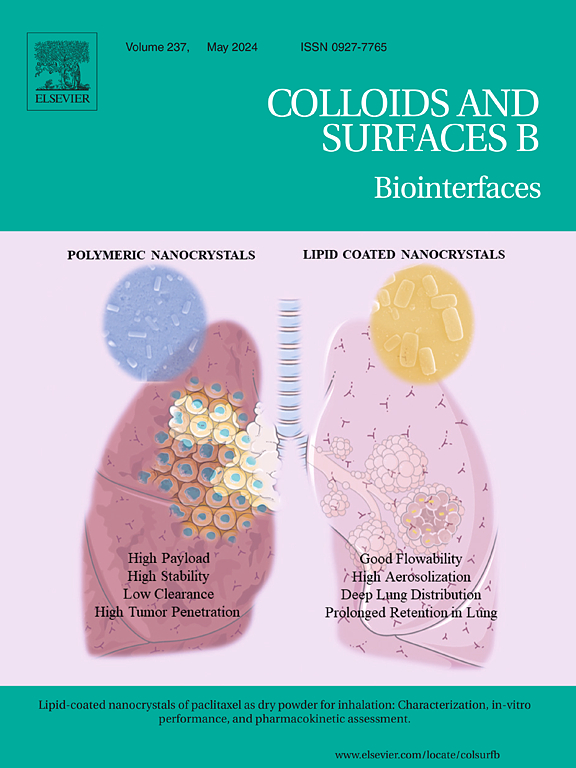基于铜-金属有机骨架、Mxene和碳纳米管的三元复合材料作为测定水生环境中多巴胺的灵敏电化学平台
IF 5.4
2区 医学
Q1 BIOPHYSICS
引用次数: 0
摘要
多巴胺(DA)是一种重要的神经递质,但过量使用会导致其作为微污染物在水生生态系统中积累,从而给人类带来各种健康风险。因此,多巴胺水平的准确测定至关重要,并在科学界和监管界引起了相当大的关注。本文采用水热法制备了一种基于铜金属有机骨架(Cu-MOF)、MXene和碳纳米管(CNTs)的三元复合材料(Cu-MOF/MXene/CNTs, MMC),用于DA的灵敏电化学检测。制备的MMC具有Cu-MOF的稳定结构、MXenes的大面积表面积和CNTs形成的众多导电通道。因此,改进的MMC在DA检测中表现出较高的性能。利用循环伏安法(CV)和差分脉冲伏安法(DPV)对MMC的电化学传感能力进行了评估。在最优条件下,峰值电流与DA浓度在0.1 ~ 50 µM范围内呈良好的线性关系,检出限低至0.035 µM。利用改进的MMC传感器对实际水样中微量DA浓度进行定量,回收率为97.3% % ~ 103% %,性能满意。实验结果表明,该复合材料对金属离子具有明显的选择性,达到了相关目的。该方法在30天内具有可接受的稳定性和良好的重现性,不同生产批次的相对标准偏差(RSD)为0.3 %。此外,还对电化学反应的动力学和潜在机理进行了全面的研究。电子和氢离子的转移促进了DA转化为多巴胺醌(DQ),这一过程因设计的传感器中活性位点的可用性增加而加速。本工作介绍了一种利用MOF、CNTs和MXene协同作用提供的活性位点和导电途径精确检测DA的方法,该方法在实验室和实际环境中都具有优异的性能,表明所提出的传感器对于检测水样中的DA非常有效。本文章由计算机程序翻译,如有差异,请以英文原文为准。
Ternary composite material based on copper-metal organic frameworks, Mxene and carbon nanotubes as a sensitive electrochemical platform for determination of dopamine in aquatic environments
Dopamine (DA) is a crucial neurotransmitter, however, its excessive use can lead to its accumulation as a micropollutant in aquatic ecosystems, thereby presenting various health risks to humans. Consequently, the accurate determination of dopamine levels is of paramount importance and has attracted considerable attention within scientific and regulatory communities. In this work, a ternary composite material (Cu-MOF/MXene/CNTs, MMC) based on copper-metal organic framework (Cu-MOF), the MXene and carbon nanotubes (CNTs) was developed using the hydrothermal method for sensitive electrochemical detection of DA. The prepared MMC possessed a stable structure derived from Cu-MOF, an extensive surface area attributed to MXenes, and numerous conductive channels formed by CNTs. Consequently, the modified MMC demonstrated high performance in DA detection. The electrochemical sensing capabilities of the MMC were assessed utilizing cyclic voltammetry (CV), and differential pulse voltammetry (DPV) methodologies. Under the optimal conditions, a strong linear relationship was observed between peak current and DA concentration within the range of 0.1–50 µM, achieving a detection limit (LOD) as low as 0.035 µM. The modified MMC sensor was utilized to quantify trace concentrations of DA in actual water samples, with recovery rates ranging from 97.3 % to 103 %, indicating satisfactory performance. Experiments were conducted to demonstrate that this composite material exhibited significant selectivity for metal ions and met related objectives. It was also shown acceptable stability over a period of 30 days and a commendable reproducibility, with a relative standard deviation (RSD) of 0.3 % across different production batches. Moreover, a comprehensive investigation was undertaken into the kinetics and underlying mechanisms of the electrochemical reaction. The transfer of electrons and hydrogen ions facilitated the transformation of DA into dopaminoquinones (DQ), a process that was accelerated by the increased availability of active sites in the designed sensor. This work introduces a method for the precise detection of DA utilizing the active sites and conductive pathways offered by the synergistic effect of MOF, CNTs and MXene, which have excellent performance in both laboratory and real environment, indicating that the proposed sensor is highly effective for detecting DA in water samples.
求助全文
通过发布文献求助,成功后即可免费获取论文全文。
去求助
来源期刊

Colloids and Surfaces B: Biointerfaces
生物-材料科学:生物材料
CiteScore
11.10
自引率
3.40%
发文量
730
审稿时长
42 days
期刊介绍:
Colloids and Surfaces B: Biointerfaces is an international journal devoted to fundamental and applied research on colloid and interfacial phenomena in relation to systems of biological origin, having particular relevance to the medical, pharmaceutical, biotechnological, food and cosmetic fields.
Submissions that: (1) deal solely with biological phenomena and do not describe the physico-chemical or colloid-chemical background and/or mechanism of the phenomena, and (2) deal solely with colloid/interfacial phenomena and do not have appropriate biological content or relevance, are outside the scope of the journal and will not be considered for publication.
The journal publishes regular research papers, reviews, short communications and invited perspective articles, called BioInterface Perspectives. The BioInterface Perspective provide researchers the opportunity to review their own work, as well as provide insight into the work of others that inspired and influenced the author. Regular articles should have a maximum total length of 6,000 words. In addition, a (combined) maximum of 8 normal-sized figures and/or tables is allowed (so for instance 3 tables and 5 figures). For multiple-panel figures each set of two panels equates to one figure. Short communications should not exceed half of the above. It is required to give on the article cover page a short statistical summary of the article listing the total number of words and tables/figures.
 求助内容:
求助内容: 应助结果提醒方式:
应助结果提醒方式:


